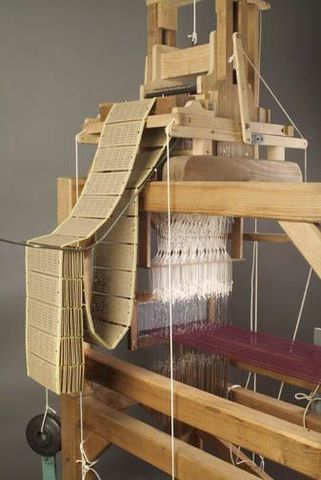Jacquard loom: Difference between revisions
Amwelladmin (talk | contribs) No edit summary |
Amwelladmin (talk | contribs) No edit summary |
||
| Line 1: | Line 1: | ||
{{anat|tech| | {{anat|tech| | ||
[[File:Jacquard loom.jpg|450px|thumb|center|An iPhone 8, 200 years ago.]] | [[File:Jacquard loom.jpg|450px|thumb|center|An iPhone 8, 200 years ago.]] | ||
}}The [[Jacquard loom]] was a power loom that simplified the process of manufacturing textiles with such complex patterns as ''brocade'', ''damask'' and ''matelassé'' with the use of punched cards. It was invented by [[Joseph Marie Jacquard]] in 1804, and | }}The [[Jacquard loom]] was a power loom that simplified the process of manufacturing textiles with such complex patterns as ''brocade'', ''damask'' and ''matelassé'' with the use of punched cards. It was invented by [[Joseph Marie Jacquard]] in 1804, and technology guru {{author|James Burke}} — a super cool seventies guy and former of great impressions on the young [[JC]] — hailed it as an early example of a computer in his magnificent, formative-impression inducing TV series, ''[[Connections]]''. | ||
Now, in 1805, was there a | Now, in 1805, was there a [[thought leader]] like former Deutsche Bank chief [[Rumours of our demise are greatly exaggerated - technology article|John “Hot Take” Cryan]] on hand to intone that, “right. that’s it. Human usefulness as we know it is over. We are all going to become machines”? | ||
Not as far as we know. Though, honestly, who knows? If there was, like Mr. Cryan, he became a victim of [[survivor bias]] and no record remains of him or his sage savouries. | |||
In the | In the meantime, what do we think happened to intricately-woven fabric now it could be quickly automated? Did this mean [[rentier]] capitalists, finally freed of the burden of wasteful servants, could reap colossal margins while their monstrous machines pumped out acres and acres of expensive fabric for an insatiable market of wealthy, but now underemployed, former hand-weavers? | ||
No. | No. | ||
| Line 13: | Line 13: | ||
''Woven fabric plummeted in price''. Of ''course'' it did. Because ''anyone'' could produce it now. All you needed was a [[Jacquard loom]]. And all of a sudden ''every bugger was buying [[Jacquard loom]]s.'' | ''Woven fabric plummeted in price''. Of ''course'' it did. Because ''anyone'' could produce it now. All you needed was a [[Jacquard loom]]. And all of a sudden ''every bugger was buying [[Jacquard loom]]s.'' | ||
And,who would have thought?<ref>Well; Adam Smith, for one.</ref> | And, who would have thought it?<ref>Well; Adam Smith, for one.</ref> Loom owners no longer needed hand-weavers. But the poor hand-weavers had no time to enjoy their new-found leisure time, much less to pen think-pieces about [[technbological unemployment]] or [[universal baseic income]], for they were needed to programme, maintain and enhance these fancy new automatic [[Jacquard loom]]s. | ||
The ex-hand-weavers re-specialised. Now the skill was ''programming the Jacquard loom'' and ''designing faster, fancier, more flexible Jacquard looms''. | |||
And what, 200 odd years later, do you think the thing you are currently staring at is? ''A faster, fancier, more flexible Jacquard loom''. | |||
{{sa}} | {{sa}} | ||
*{{aiprov|Rumours of our demise are greatly exaggerated}} | *{{aiprov|Rumours of our demise are greatly exaggerated}} | ||
{{ref}} | {{ref}} | ||
Revision as of 17:35, 24 August 2020
|
JC pontificates about technology
An occasional series. 
|
The Jacquard loom was a power loom that simplified the process of manufacturing textiles with such complex patterns as brocade, damask and matelassé with the use of punched cards. It was invented by Joseph Marie Jacquard in 1804, and technology guru James Burke — a super cool seventies guy and former of great impressions on the young JC — hailed it as an early example of a computer in his magnificent, formative-impression inducing TV series, Connections.
Now, in 1805, was there a thought leader like former Deutsche Bank chief John “Hot Take” Cryan on hand to intone that, “right. that’s it. Human usefulness as we know it is over. We are all going to become machines”?
Not as far as we know. Though, honestly, who knows? If there was, like Mr. Cryan, he became a victim of survivor bias and no record remains of him or his sage savouries.
In the meantime, what do we think happened to intricately-woven fabric now it could be quickly automated? Did this mean rentier capitalists, finally freed of the burden of wasteful servants, could reap colossal margins while their monstrous machines pumped out acres and acres of expensive fabric for an insatiable market of wealthy, but now underemployed, former hand-weavers?
No.
Woven fabric plummeted in price. Of course it did. Because anyone could produce it now. All you needed was a Jacquard loom. And all of a sudden every bugger was buying Jacquard looms.
And, who would have thought it?[1] Loom owners no longer needed hand-weavers. But the poor hand-weavers had no time to enjoy their new-found leisure time, much less to pen think-pieces about technbological unemployment or universal baseic income, for they were needed to programme, maintain and enhance these fancy new automatic Jacquard looms.
The ex-hand-weavers re-specialised. Now the skill was programming the Jacquard loom and designing faster, fancier, more flexible Jacquard looms.
And what, 200 odd years later, do you think the thing you are currently staring at is? A faster, fancier, more flexible Jacquard loom.
See also
References
- ↑ Well; Adam Smith, for one.